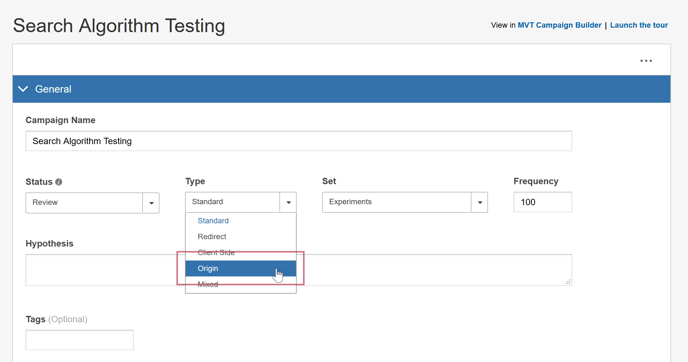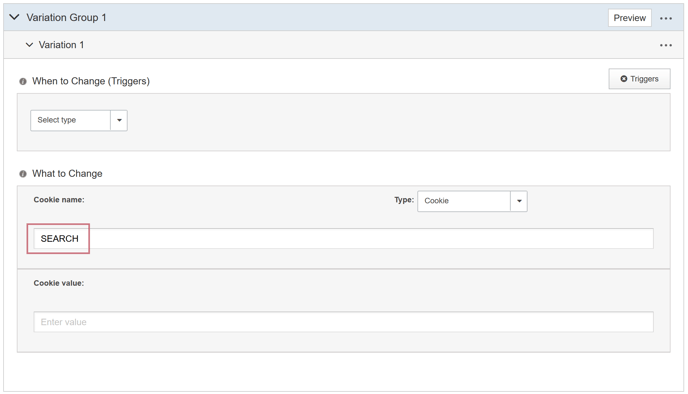To create an Origin Experiment, select New, A/B Campaign.
Definition
In the General section of the page:
- Enter a Name and select a Status.
- Select Origin from the Type drop-down. SiteSpect automatically selects Origin Experiments in the Set field.

- Complete the rest of the General section.
Variations
In the Variations section of the page:
- Open the Original area.
- The When to Change area identifies the pages you want to modify. You can use a simple URL pattern, an attribute in the page source, or combine multiple Triggers to identify a single page or a group of pages.
- In the What to Change area, enter your cookie name in the Cookie Name field. This is the default cookie name, SEARCH, for example.
Note: There are several other Types available in Origin Experiments: Header, URL, Query Parameter, 301 Redirect, and 302 Redirect. They are explained later in this topic.
- In the Cookie Value field, enter the value of the default experience. The fields have been completed in the following image. The Cookie Value is the value that is used in the Cookie for visitors assigned to the control (original).

- Open Variation Group 1. You can see in the following image that the Cookie Name field is already complete with the Cookie Name you entered above. If you change the name above, it is changed here and vice versa: if you change it here, it is changed above.

- In the Cookie Value field, enter the value of the alternative experience. This is the value that is used in the Cookie for visitors assigned to this Variation.
Other Types of Origin Experiment Variations
In the What to Change area of the Variation, SiteSpect offers several different types of Origin Experiment Variations in addition to the Cookie type:
- Use the Header type when you want to signal to the origin using an HTTP header. This is similar to the Cookie type but you are signaling using an arbitrary request header. You can use it for the same use cases as signaling with a cookie. When you select Header, an additional checkbox is available called Visible Only to the Origin. If you check this box, SiteSpect adds this header name to the comma-delimited set of values for the response header named Access-Control-Expose-Headers. If that header is not already being sent, SiteSpect adds it.
- Use a URL type when you want to change the path or URI of the request. All Origin Experiments execute in SiteSpect on the request, so this type is very similar to a redirect factor but it is “direct”, meaning it changes direction before the request goes to the origin. All redirect use cases apply here. For example, you might want to publish a new page in your CMS and use an Origin Experiment URL type to test that new page. The visitor requests Page A; SiteSpect changes that request to Page B. The origin responds with Page B and the visitor sees the result of Page B while still seeing the browser URL for Page A.
- Use a Query Parameter when you want to add or modify query parameters in the request. This is similar to the URL type, but instead of changing the path of the request, you are changing the query parameters in the request. As a result, SiteSpect changes the request to the origin to signal the origin as part of the campaign.
- Use a 301 Redirect to tell the browser to redirect permanently to a new URL.
- Use a 302 Redirect to tell the browser to redirect temporarily to a new URL.
Finishing the Campaign
- Select any Metrics or Audiences that you require.
- Save the Campaign.
Other Methods of Release Testing
You can also test a release using our Admin API, which is intended to help automate release testing